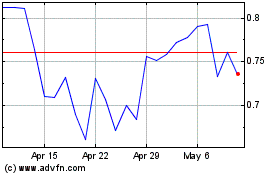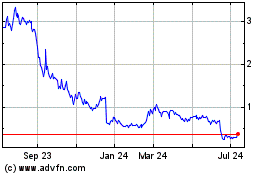Cara Initiates Phase 2 Trial of Oral KORSUVA™ for the Treatment of Pruritus in Patients with Notalgia Paresthetica
January 11 2021 - 7:00AM

Cara Therapeutics, Inc. (Nasdaq: CARA), a biopharmaceutical company
focused on developing and commercializing new chemical entities
designed to alleviate pruritus by selectively targeting peripheral
kappa opioid receptors, today announced the initiation of a Phase 2
trial of Oral KORSUVA™ (difelikefalin) for the treatment of
moderate-to-severe pruritus in patients suffering from notalgia
paresthetica (NP), a nerve disorder characterized by chronic
pruritus of the upper to middle back.
“We are excited to initiate this Phase 2 trial
and further expand the potential of Oral KORSUVA™ in the treatment
of moderate-to-severe pruritus in patients with notalgia
paresthetica to help address the burden that these patients face,”
said Joana Goncalves, M.D., Chief Medical Officer of Cara
Therapeutics. “Evaluating the ability to treat pruritus of a
neuropathic origin, in addition to our current clinical development
programs in systemic and dermatological chronic pruritus, will
further support the potential of Oral KORSVUA™ as a broad
anti-pruritic agent.”
“Notalgia paresthetica is a common condition
that is challenging to manage and impacts the quality of life of
patients living with it,” said Mark Lebwohl, M.D., Professor and
Dean for Clinical Therapeutics and Chairman Emeritus of the
Department of Dermatology at Icahn School of Medicine at Mount
Sinai. “I am thrilled to be a part of this pioneering study that
has the potential to generate a novel therapeutic option for this
unmet need in patients with NP.”
Phase 2 Trial Design
The Phase 2 multicenter, randomized,
double-blind, placebo-controlled 8-week study is designed to
evaluate the efficacy and safety of Oral KORSUVA™ for
moderate-to-severe pruritus in approximately 120 subjects with NP.
Subjects will be randomized to Oral KORSUVA™ 2 mg taken twice daily
(BID) vs. placebo for 8 weeks, followed by a 4-week active
extension phase.
The primary efficacy endpoint is the change from
baseline in the weekly mean of the daily 24-hour Worst
Itch-Numeric Rating Scale (WI-NRS) score at Week 8 of the
treatment period. Secondary endpoints include change from baseline
in itch-related quality of life scores at the end of Week 8 and
safety assessments.
About Pruritus Associated with Notalgia
Paresthetica
Notalgia paresthetica (NP) is a common, although
under-recognized chronic, sensory neuropathy affecting the upper
back.1 It is estimated that chronic pruritus affects up to 13% of
the United States population, and about 8% of these patients suffer
from neuropathic itch , including NP.2,3 One of the hallmark
features of NP is chronic pruritus, which can be significantly
burdensome and undermines the affected subject’s quality of life
and overall well-being.3 The exact etiology of NP still has not
been fully elucidated; however, it is widely accepted that NP is a
sensory neuropathy caused by alteration and damage to thoracic
spinal nerves.3
The management of NP is challenging and is often
resistant to multiple therapies. There is currently no well-defined
treatment for NP and conventional treatments for pruritus, such as
antihistamines and topical steroids are largely ineffective.4
References:
- Matthew Howard, Lukas Sahhar, Frank
Andrews, Ralph Bergman and Douglas Gin. Notalgia paresthetica: a
review for dermatologists. International J of Dermatology 2018,57,
388-392.
- Manuel P. PEREIRA, Hannah LÜLING,
Annette DIECKHÖFER, Sabine STEINKE, Claudia ZEIDLER and Sonja
STÄNDER. Brachioradial Pruritus and Notalgia Paraesthetica: A
Comparative Observational Study of Clinical Presentation and
Morphological Pathologies. Acta DV 2018 ; 98:82-88.
- Mollanazar, N.K., Koch, S.D. &
Yosipovitch, G. Epidemiology of Chronic Pruritus: Where Have We
Been and Where Are We Going?. Curr Derm
Rep 4, 20–29 (2015)Mirna Šitum, Maja
Kolić, Nika Franceschi and Marko Pećina. Notalgia Paresthetica.
Acta Clin Croat 2018; 57:721-725
- Ahmed Ansari, David Weinstein &
Naveed Sami. Notalgia paresthetica: treatment review and
algorithmic approach. Journal of Dermatological Treatment
2019.
About Cara
Therapeutics
Cara
Therapeutics is a clinical-stage biopharmaceutical company
focused on developing and commercializing new chemical entities
designed to alleviate pruritus by selectively targeting peripheral
kappa opioid receptors, or KORs. Cara is developing a novel and
proprietary class of product candidates, led by KORSUVA™
(CR845/difelikefalin), a first-in-class KOR agonist that targets
the body’s peripheral nervous system, as well as certain immune
cells. The Company has submitted a New Drug Application (NDA) to
the U.S. Food and Drug Administration (FDA) for KORSUVA™
Injection (difelikefalin) for the treatment of moderate-to-severe
pruritus in hemodialysis patients. KORSUVA Injection received
Breakthrough Therapy Designation from the FDA for this indication.
Cara has requested Priority Review for the NDA which, if granted,
could result in a six-month review process. Oral KORSUVA has
successfully completed a Phase 2 trial for the treatment of
pruritus in patients with CKD and is currently in Phase 2 trials in
atopic dermatitis and primary biliary cholangitis patients with
moderate-to-severe pruritus.
The FDA has
conditionally accepted KORSUVA™ as the trade name for difelikefalin
injection. CR845/difelikefalin is an investigational drug product
and its safety and efficacy have not been fully evaluated by any
regulatory authority.
Forward-looking
Statements
Statements contained in this press
release regarding matters that are not historical facts are
"forward-looking statements" within the meaning of the Private
Securities Litigation Reform Act of 1995. Examples of these
forward-looking statements include statements concerning the
potential for Oral KORSUVA to be a therapeutic option for pruritus
related to NP, or other pruritus of a neuropathic origin, or in
systemic and dermatological chronic pruritus. Because such
statements are subject to risks and uncertainties, actual results
may differ materially from those expressed or implied by such
forward-looking statements. Risks are described more fully in
Cara's filings with the Securities and Exchange Commission,
including the "Risk Factors" section of Cara's Quarterly Report on
Form 10-Q for the quarter ended September 30, 2020 and
its other documents subsequently filed with or furnished to
the Securities and Exchange Commission. All forward-looking
statements contained in this press release speak only as of the
date on which they were made. Except to the extent required by law,
Cara undertakes no obligation to update such statements to reflect
events that occur or circumstances that exist after the date on
which they were made.
MEDIA CONTACT: Annie Starr6
Degrees973-768-2170astarr@6degreespr.com
INVESTOR CONTACT:Janhavi Mohite Stern Investor
Relations, Inc.janhavi.mohite@SternIR.com
Cara Therapeutics (NASDAQ:CARA)
Historical Stock Chart
From Mar 2024 to Apr 2024

Cara Therapeutics (NASDAQ:CARA)
Historical Stock Chart
From Apr 2023 to Apr 2024
